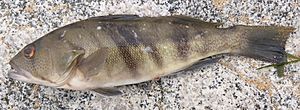Barred sand bass facts for kids
Quick facts for kids Barred sand bass |
|
|---|---|
 |
|
| Conservation status | |
| Scientific classification | |
| Synonyms | |
|
Labrax nebulifer Girard, 1854 |
The barred sand bass (scientific name: Paralabrax nebulifer) is a type of fish. It belongs to the sea bass and grouper family, called Serranidae. This fish lives in the ocean waters near California and Baja California in the eastern Pacific Ocean.
Contents
About the Barred Sand Bass
What Does It Look Like?
The barred sand bass can grow quite large. It can be about 67 centimeters (26 inches) long. It can also weigh up to 6 kilograms (13 pounds).
Its body is long and a bit flat from side to side. It is gray-white with dark stripes going up and down. Its belly is usually whitish. This fish has a big mouth. Its lower jaw sticks out a little bit.
How to Tell It Apart from Other Fish
The barred sand bass looks a lot like some other fish. The spotted sand bass (P. maculatofasciatus) is similar. But you can tell it apart because the spotted sand bass has small spots all over its body.
Both the barred and spotted sand bass have a longer third spine on their back fin. This helps tell them apart from the kelp bass (P. clathratus). The kelp bass has back fin spines that are all about the same length.
Where Barred Sand Bass Live
Barred sand bass are found along the coast. Their home range stretches from Santa Cruz, California down to Magdalena Bay in Baja California Sur, Mexico.
Life in the Ocean
Their Home and Food
This fish likes to live in shallow ocean waters. You can find them in depths up to 600 feet (about 183 meters). They are most often caught in waters that are 60 to 90 feet deep (about 18 to 27 meters). They prefer to live on sandy parts of the ocean floor.
The barred sand bass eats other fish. One of their favorite foods is the plainfin midshipman. They also eat small ocean creatures without backbones, called invertebrates. Young barred sand bass eat many kinds of tiny invertebrates and small fish.
How They Reproduce
During warmer months, barred sand bass gather together to lay eggs. They are "pelagic spawners." This means they release their eggs freely into the water. The eggs then float around until they hatch.
Like some other fish in their group, barred sand bass can sometimes change sex. Some individuals might change from female to male as they get older and bigger. However, most of them do not change sex.
Fishing and Conservation
The barred sand bass is a very popular fish for sport fishing in Southern California. Scientists from the California Department of Fish and Wildlife study their populations. These studies show that the number of barred sand bass is stable.
This is likely because of rules for recreational fishing. Also, it is against the law to catch them for commercial fishing. The fish may also be helped by special protected areas along the California coast. These areas keep their habitats safe.


